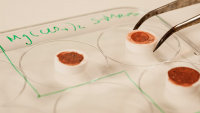Perchlorate enhancing the rate of bacterial death on Mars

Scientists have discovered that UV light can ‘activate’ perchlorate under Martian environmental conditions, causing it to enhance the rate of bacterial death.
Professor Charles Cockell and Jennifer Wadsworth have discovered that perchlorate, which is a molecule that is abundant on the surface of Mars, can enhance the rate of bacterial death when 'activated'. Perchlorate is usually very stable at room temperature/colder temperatures and you have to heat it to hundreds of degrees Celsius to activate it. However, it has been shown that UV light can 'activate' it under Martian environmental conditions. They suspect the UV light causes it to decay into a different molecule which is lethal for bacteria.
The other major finding is that if you mix other components of the Martian surface (iron oxides and hydrogen peroxide) with the perchlorate, the lethal effect on bacteria is increased. This is interesting because it is generally thought that it would not be possible to activate perchlorate under Martian conditions. Astrobiologists will take this into consideration when looking for biomarkers/life on Mars.
Jennifer Wadsworth commented: "We already know the surface is probably inhospitable, so future missions might look at potential subsurface environments for life. We don’t know exactly how far the effect of UV and perchlorate would penetrate the surface layers, as the precise mechanism isn’t understood. If it’s the case of altered forms of perchlorate diffusing through the environment, that might extend the uninhabitable zone. We may have to dig a little deeper to find a potential habitable environment."

